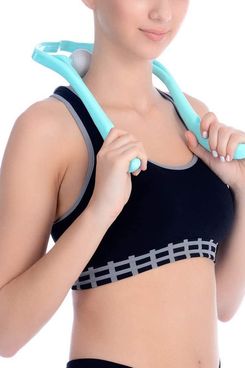
If your neck and shoulders are aching from looking down at your computer all day long (or from leaning over the sink washing dishes now that you’re cooking constantly), you’re not alone. I’ve been struggling with pain in my neck and shoulders as long as I can remember, likely because my posture is terrible. I slouch like a bored eighth-grader in every chair I sit in, and am always hunched over while typing or scrolling through my phone. I cleverly gave my boyfriend the $200 version of the $600 Theragun massager loved by professional athletes (and at least one Strategist writer) for Christmas last year with the assumption that I would be the one to actually use it. The joke was on me, because I wound up hating it while he’s in love with the thing.
The Theragun definitely has its uses — it’s great for lower back pain and bouts of sciatica — but all I want from a massager is relief from my stiff neck and tight upper shoulders. Using the Theragun anywhere near your neck is a nightmarish experience; the vibration makes it feel like your teeth are about to rattle right out of your head. When you use it around your shoulder blades, it feels like it’s drilling straight through your skin and into the bone.
I should have just saved my money. Nothing has given me real relief from neck and shoulder pain like this $12.99 hunk of baby-blue plastic with two rubber golf balls attached that I recently discovered at my local Korean supermarket.
This low-tech gadget is meant to deliver an amount of pressure on trigger points (also known as knots) that only the hands of an actual massage therapist can usually provide. Seeing how going to get a massage from another human is out of the question right now, this is the next best thing. And unlike the Theragun, the fact that it is totally silent means you can use it any time you please — even in the middle of a conference call.
I keep it on my desk and use it to release tension in the back of my skull, in the muscles along the base of my skull, and down the sides of my neck. Sometimes I use it across the tops of my shoulder blades, but a physical therapist I chatted with at a party once said that shoulder pain is almost always what is known as a referring pain — meaning it’s actually coming from somewhere else, and that somewhere is usually the neck. I find that when I work the right spots on my neck consistently for 10 to 15 minutes a few times a day, I get serious, long-lasting shoulder pain relief that no massage therapist, no matter how fancy, has ever been able to achieve. (One caveat: It’s best to put your hair up and use a little oil or lotion on your neck and shoulders to help the balls glide as they go — otherwise it can tend to drag and pinch your skin.)
You might see that there are a million different versions of this thing all over the web, but they are basically identical, and it honestly doesn’t matter which one you buy. Get the one I am talking about here, or get this one, this one, or even this black-and-silver one! They are all the same simple, perfect, low-tech problem-solver no matter which one you get. Just don’t get suckered into paying more than $15 for one.
The Strategist is designed to surface the most useful, expert recommendations for things to buy across the vast e-commerce landscape. Some of our latest conquests include the best acne treatments, rolling luggage, pillows for side sleepers, natural anxiety remedies, and bath towels. We update links when possible, but note that deals can expire and all prices are subject to change.






